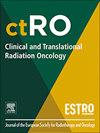Effectiveness, toxicity and impact on quality of life of high-dose-rate brachytherapy delivered in two fractions as monotherapy in patients with prostate cancer
IF 2.7
3区 医学
Q3 ONCOLOGY
引用次数: 0
Abstract
Purpose
The aim of this retrospective, single-center cohort study was to evaluate the effectiveness and safety of two-fraction high-dose-rate brachytherapy (HDR-BT) as monotherapy in a consecutive cohort of prostate cancer patients.
Methods
We included consecutive patients who received 28 Gy HDR-BT in two fractions (14 Gy × 2) as monotherapy during 2005 to 2021 at our institution. Eligible patients were derived from an institutional database consisting of prospectively collected data. Primary endpoint was biochemical recurrence (BCR) and secondary endpoints included toxicity (assessed through both healthcare provider and patient-reported outcomes) and quality-of-life (QoL) assessment.
Results
In total, 175 patients with prostate cancer (94 % classified as low- or intermediate-risk) were treated with HDR-BT during the study period with a median age of 68 years (range: 51–80), and a median follow-up of 60 months (range: 0–174). The estimated five-year cumulative BCR rate was 3.0 % (95 % Confidence Interval (CI): 0 %–13.3 %) for low-risk patients and 9.6 % (95 % CI: 4.7 %–16.7 %) for intermediate-risk patients. PSA exceeding 10 ng/mL at diagnosis was a significant risk factor for BCR (Odds Ratio (OR) = 3.29, 95 % CI: 1.01–10.67) whereas PSA of ≤0.1 ng/ml as nadir was a significant positive prognostic factor, associated with lower risk of BCR (OR = 0.11, 95 % CI: 0.03–0.33). At 12 months, 22 % of the patients had grade 2 and 3 % grade 3 urinary toxicity whereas 2 % of patients had grade 2 and none grade 3 bowel toxicity. At 12 months, 49 % of the patients with at least some erectile function before the treatment, had an impaired function.
Conclusion
We found that two-fraction HDR-BT as monotherapy among patients with mainly low- and intermediate-risk prostate cancer appears to be safe in terms of biochemical recurrence, with a low proportion of severe urinary and bowel toxicity.
前列腺癌患者高剂量率近距离放射治疗的有效性、毒性和对生活质量的影响
目的:本回顾性单中心队列研究的目的是评估两部分高剂量率近距离放射治疗(HDR-BT)作为单一疗法在前列腺癌患者连续队列中的有效性和安全性。方法:我们纳入了2005年至2021年在我们机构接受28gy HDR-BT分两部分(14gy × 2)作为单药治疗的连续患者。符合条件的患者来自机构数据库,包括前瞻性收集的数据。主要终点是生化复发(BCR),次要终点包括毒性(通过医疗保健提供者和患者报告的结果评估)和生活质量(QoL)评估。结果:在研究期间,共有175例前列腺癌患者(94%为低或中危)接受了HDR-BT治疗,中位年龄为68岁(范围:51-80),中位随访时间为60个月(范围:0-174)。估计低危患者的5年累积BCR率为3.0%(95%置信区间(CI): 0% - 13.3%),中危患者为9.6% (95% CI: 4.7% - 16.7%)。诊断时PSA超过10 ng/mL是BCR的重要危险因素(比值比(OR) = 3.29, 95% CI: 1.01-10.67),而PSA最低≤0.1 ng/mL是一个重要的阳性预后因素,与BCR的低风险相关(OR = 0.11, 95% CI: 0.03-0.33)。在12个月时,22%的患者有2级和3%的患者有3级尿毒性,而2%的患者有2级肠毒性,没有3级肠毒性。在12个月时,治疗前至少有一些勃起功能的患者中有49%的功能受损。结论:我们发现,在低、中危前列腺癌患者中,双组分HDR-BT单药治疗在生化复发方面是安全的,出现严重尿毒性和肠毒性的比例较低。
本文章由计算机程序翻译,如有差异,请以英文原文为准。
求助全文
约1分钟内获得全文
求助全文
来源期刊

Clinical and Translational Radiation Oncology
Medicine-Radiology, Nuclear Medicine and Imaging
CiteScore
5.30
自引率
3.20%
发文量
114
审稿时长
40 days
 求助内容:
求助内容: 应助结果提醒方式:
应助结果提醒方式:


